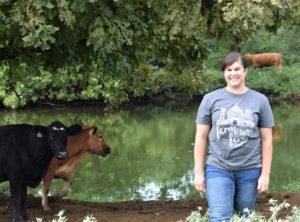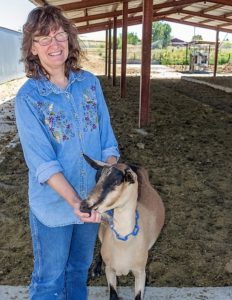
Emery expanded her herd to 20 cows with operating loans from FSA.
By Lauren Moore, USDA
Spring planting is starting across the country when many agricultural producers are investing in their future. It is no doubt that farming and ranching is a capital-intensive business. From growing row crops to raising livestock or running a specialty operation, operating funds are essential. The stakes are even higher when it comes to purchasing a farm or ranch.
As farmers and ranchers continue to be impacted by natural disasters and the changing farm economy, farm loans become increasingly important. Fortunately, the 2018 Farm Bill provides increased loan limits and more flexibility to farm loans, which gives producers more access to credit when they need it most.
Farm loan programs from USDA’s Farm Service Agency (FSA) offer direct and guaranteed loans to farmers and ranchers to promote, build, and sustain family farms for a thriving agricultural economy. Here are just a few examples on how our farm loans have helped agriculture operations across the country.
Farm Operating Loans
Emery Fox is a 26-year-old rancher in Checotah, Oklahoma, who got in the cattle business two years ago.
Starting out with a herd of 12 Charolais-Red Angus cattle, Emery expanded her herd to 20 cows with operating loans from FSA.
“It’s an easy process and a way for me to get a much better interest rate than I could have otherwise,” Emery said. “If you do your research, there are plenty of programs and resources out there.”
Operating loans help producers pay for normal operating expenses, including machinery and equipment, seed, livestock feed, and more. The direct operating loan limit increased from $300,000 to $400,000, and the guaranteed operating loan limit increased from $1.429 million to $1.75 million.

Debra was able to purchase the farm she was leasing with the help of a farm ownership loan.
Farm Ownership Loans
Debra Jantzi and her nine children operate Treasured Sunrise Acres, a goat dairy, in the Treasure Valley of western Idaho. Prior to opening the dairy, the Jantzi kids were involved with their local 4-H club. Each child had their own small goat herd and were responsible for keeping the records on feeding, breeding, and marketing.
When they decided to open a dairy, a retired dairyman leased his farm to Debra. With the help of a farm ownership loan, she was able to eventually purchase the property.
“FSA has been a life saver for us. We wanted to grow and could not on our own,” Debra said. “This family-owned dairy has provided my children a lifestyle where they can be together, develop their skills, and have fun. The operation is fluid, constantly changing and adapting.”
Ownership loans help producers become owner-operators of family farms as well as improve and expand current operations. The direct farm ownership loan limit increased from $300,000 to $600,000, and the guaranteed farm ownership loan limit increased from $1.429 million to $1.75 million.
Microloans

The Staleys grew their maple syrup operation with a microloan.
Mike and Kim Staley purchased their Elmwood, Illinois, maple syrup farm in 2007.
“We got into this business by accident,” said Mike. “After watching the documentary, I told my wife that we should try making maple syrup, seeing as there were maple trees on our property already. She got me a starter kit for Christmas and we made 15 bottles that year.”
With a microloan from FSA, the Staleys were able to grow their operation, adding a sink, range and cooler, along with a well, septic system and a roof for the sugar house. Cramer Creek Farm produced 60 gallons of syrup in 2018, with hopes to make 100 gallons in 2019.
Microloans provide flexible access to credit for small, beginning and niche agricultural operations. Producers, like the Staley’s, can now receive both a $50,000 farm ownership microloan and a $50,000 operating microloan. Previously, microloans were limited to a combined $50,000.
More Information
USDA offers a variety of risk management, disaster assistance, loan, and conservation programs to help agricultural producers across the country weather ups and downs in the market and recover from natural disasters as well as invest in improvements to their operations. Learn about additional programs.
For more information on FSA farm loans, visit www.fsa.usda.gov or contact your local USDA service center.





